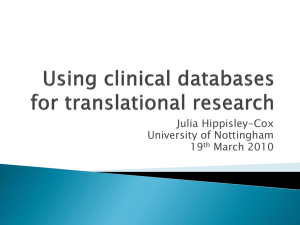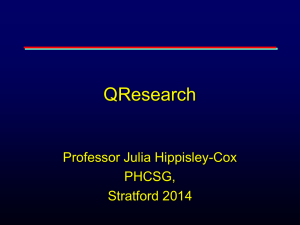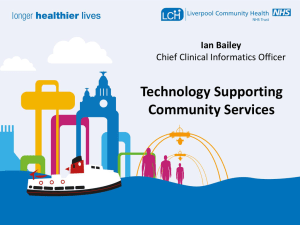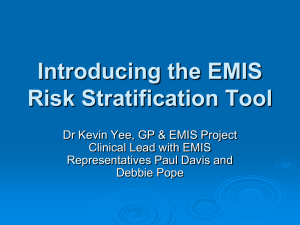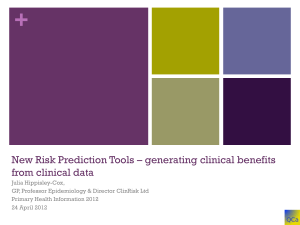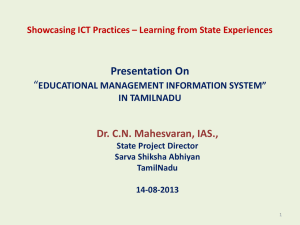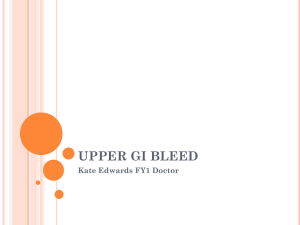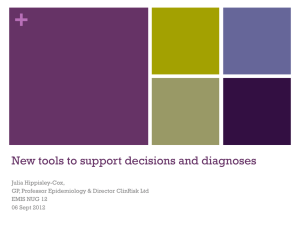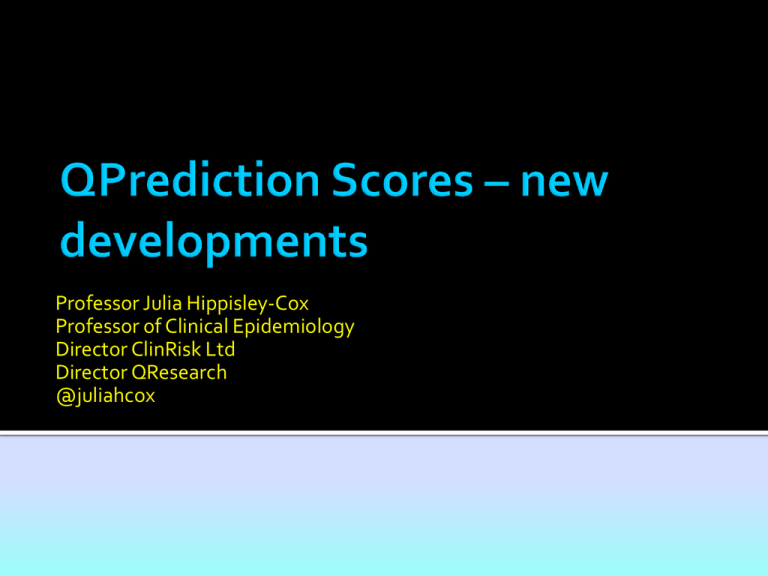
Professor Julia Hippisley-Cox
Professor of Clinical Epidemiology
Director ClinRisk Ltd
Director QResearch
@juliahcox
Co-authors
QResearch database - EMIS practices, EMIS,
Nottingham University
EMIS NUG (including screencasts)
ClinRisk Ltd (development & software)
Office National Statistics (mortality data)
HSCIC (pseudonymised HES data)
QBleed Algorithm
QBleed + QStroke
Update on tools integrated into EMIS Web
Embargoed until publication
Individual assessment
Who is most at risk of current or preventable
disease?
Who is likely to benefit from interventions?
What is the balance of risks and benefits for my
patient?
Enable informed consent and shared decisions
Population risk stratification
Identification of rank ordered list of patients for
recall or reassurance
GP systems integration
Allow updates tool over time, audit of impact on
services and outcomes
Anticoagulants
used in prevention & treatment of VTE
To reduce risk ischaemic stroke with AF
Although use of anticoagulants in AF is in
QOF uptake is low
Legitimate concerns around safety
particularly risk of major bleeds
Need to quantify absolute risk of bleed to
help make informed decision on risk/benefit
When discussing benefits and risk of
anticoagulation in AF explain that
For most people benefit exceeds risk
Except for those with increased bleeding risk
where careful monitoring required
Discuss options and base choice on their
clinical features and preferences
Only treat after informed discussion on risks
& benefits
http://www.nice.org.uk/guidance/cg180/chapter/1-recommendations
Currently recommends HAS-BLED score
Scoring system major bleed in AF
Derived from 3978 hospital based patients
Not externally validated
Risk factors for HAS-BLED v similar to
CHADS stroke
Simple scoring system not measure of
absolute risk
Hypertension
Renal disease
Liver disease
Prior Stroke
Prior bleed or predisposition
Age 65 (yes/no)
Medication (antiplatelets, NSAID)
Alcohol (> 8 units/week)
Labile INR – but supposed to be for new users
so INR wont be available!
Embargoed until publication
Develop new risk algorithm which
Predict 1yr & 5yr absolute risk of GI and
intracranial bleed
new users anticoagulants c.f. non-use
Includes clinically relevant variables ameliorable
to change
Can be implemented in routine GP systems
Can be shared with patient to help inform
decision making
Can be updated regularly
Embargoed until publication
Developed using QResearch database
Very large validated GP database
Derived from EMIS (largest GP supplier)
Representative ethnically diverse population
Linked to Hospital Episode Statistics
Linked to ONS cause of death data
Embargoed until publication
Design: Cohort study
Study period: 2008-2013
Patients: 4.4 million aged 21-99 years
Baseline: assessment of predictive factors
focused on
clinically relevant variables
primary care
Outcome: GI bleed or intracranial bleed on
linked mortality or hospital data
Embargoed until publication
Intracranial bleed 9,040 cases on
QResearch linked hospital or
mortality records
Upper GI bleed 21,614 cases on
QResearch linked hospital or
mortality records
Largest ever such study. Increases
reliability of results and generalisability
of findings
Age, sex, BMI
Ethnicity
Deprivation
Smoking & alcohol
Abnormal platelets
Medication
Antiplatelets
NSAIDS
Steroids
Antidepressants
Anticonvulsants
Atrial fibrillation
Heart Failure
Treated hypertension
Cancer
Liver disease/pancreatitis
Oesophageal varices
VTE
Prior bleed (GI, brain,
haematuria,haemoptysis)
Gold standard to test performance of risk tool
on separate population
We used 2 validation samples
Different practices in QResearch (from EMIS)
Different practices in CPRD (from Vision Practices)
Women
Men
Higher values
indicates better
discrimination
Upper GI bleed
ROC
0.77
0.75
R2
40.7
36.9
D statistic
1.7
1.57
0.85
0.81
R2
58
53.3
D statistic
2.4
2.2
Intracranial bleed
ROC
Similar results
CPRD and
QResearch
Fig 3 Mean predicted risks and observed risks at five years by 10th of predicted risk applying
QBleed risk prediction scores to all patients in QResearch validation cohort.
Hippisley-Cox J , and Coupland C BMJ
2014;349:bmj.g4606
©2014 by British Medical Journal Publishing Group
Cut off 5 year
risk (%)
Sensitivity
(%)
Observed risk
(%)
Upper GI bleed
1.4%
38%
2.7%
Intracranial bleed
0.7%
51%
1.5%
For example, using threshold of top 10% at risk will correctly
identify
38% of those who get upper GI bleed
51% of those who get intracranial bleed
QBLEED
4.4 million GP patients
30,681 events
2 clear outcomes
Followed over 5 years
Absolute risk
Includes more clinically
relevant factors
Externally validated
Easy to update over time
HAS-BLED
4,000 hospital patients
53 events
Unclear what ‘major bleed’ is
Followed over 1 year
Simple count only
Includes INR which wont have
prior to Rx
Not externally validated
Unclear about updates
“Such a model represents a change in our
approach to assessing bleeding risk, from
simple, point based scores, to a more
inclusive, complex model”.
“While there may be implications for
implementation, this progression may
make sense clinically—there are often
patient subtleties and characteristics that
inevitably increase the risk of bleeding but
are not captured in simpler scores”.
“While calculating bleeding risk is no
longer “simple,” neither is the decision to
use long term anticoagulation”.
“This is among the largest of the
outpatient derivation cohorts used in
this specialty to date and provides extra
power to develop more robust
predictive models using more candidate
covariates than other scores”.
“A more comprehensive model may adjust for
these factors, giving doctors and their patients a
more refined estimate of absolute risk”.
How should GPs use risk estimates
when making decisions about
bleeding?
What risk is too high?
Is threshold same for every patient
& every indication?
Are there patients for whom extra
risk is negligible compared with
underling stroke risk?
Estimates risk of ischaemic stroke over 1-10
years
Includes age, sex, ethnicity, deprivation
Smoking, diabetes, AF, CCF, CVD
Rheumatoid, chronic renal disease
Valvular heart disease
Treated hypertension and FH CHD
SBP, cholesterol, BMI
Integrated into EMIS WEB
Embargoed until publication
http://qbleed.org/plus-qstroke
75yr old man with AF, light smoker, heavy alcohol, NSAIDS
ALREADY IN EMIS WEB
QRISk2
QDiabetes
QStroke
QFracture
(QAdmissions)
IN PLANNING PHASES
QCancer (release 4.11)
QKidney
QThrombosis
QBleed
QIntervention
http://bmjopen.bmj.com/content/4/8/e005809.abstract
EMIS NUG screen casts courtesy of Dr
Geoff Schrecker & EMIS NUG
http://emisnug.org.uk/video/addingcalculation-template-emis-web
http://emisnug.org.uk/video/runningcalculation-eg-qrisk-group-patients-batchadd
http://www.emisnug.org.uk/
Currently around 800 practices contributing
Would like around 1000
Pseudonymised data with no strong
identifiers
IG approved EMIS NUG, REC, BMA, RCGP
Only used for research
All research peer reviewed and published
Need to activate QResearch in EMIS Web
even if sharing data for many years via LV
www.qresearch.org
http://emisnug.org.uk/video/add-rbacactivity-emis-web-user-profile
http://emisnug.org.uk/video/enablingsharing-agreements-qsurveillance-andqresearch

